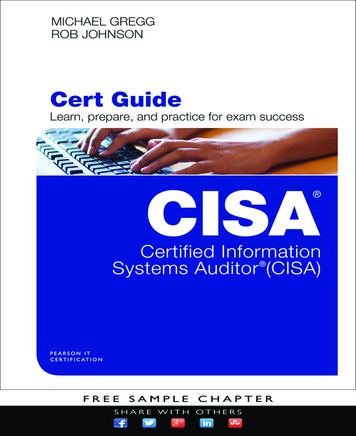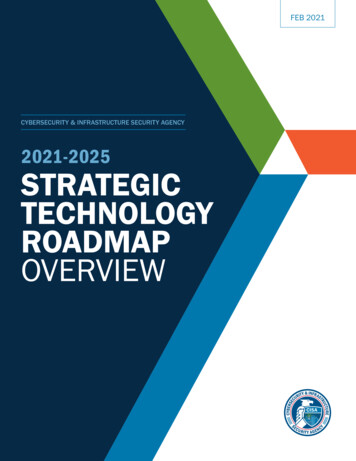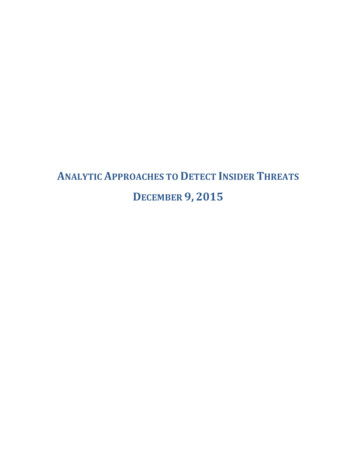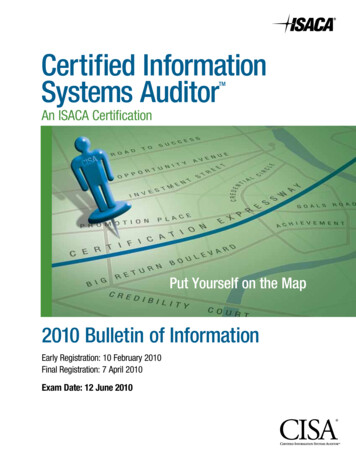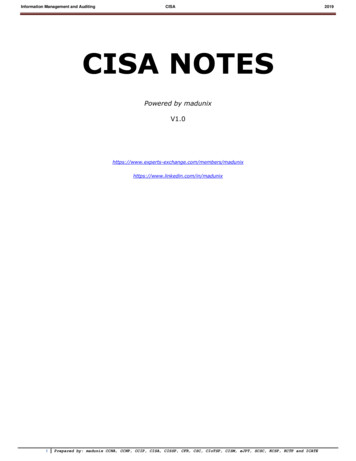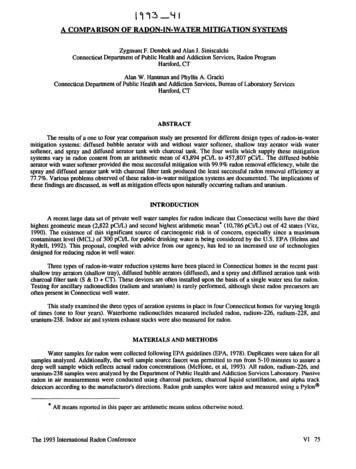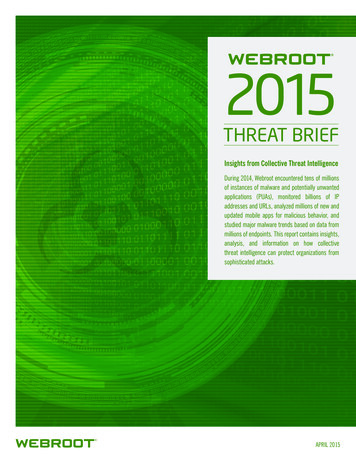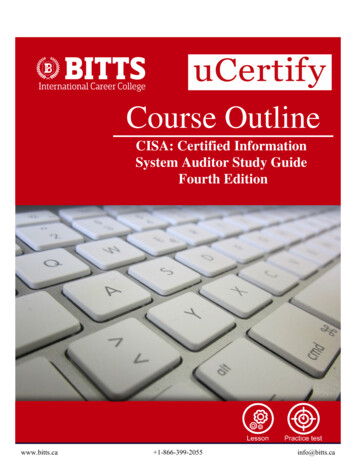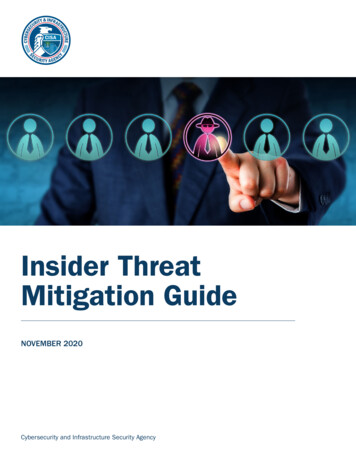
Transcription
Insider ThreatMitigation GuideNOVEMBER 2020Cybersecurity and Infrastructure Security Agency
[This page left intentionally blank]
Insider Threat Mitigation GuideTable of ContentsLetter from the Acting Assistant Director. vIntroduction. 1Costs of Insider Threats.2Return on Investment for Insider Threat Mitigation Programs.4Insider Threat Mitigation Program .5Defining Insider Threats. 8Definition of an Insider.9Definition of Insider Threat.10Types of Insider Threats.12Expressions of Insider Threat.13Concluding Thoughts.18Key Points.19Building an Insider Threat Mitigation Program. 20Characteristics of an Effective Insider Threat Mitigation Program.21Core Principles.23Keys for Success.26Establishing an Insider Threat Mitigation Program.28Concluding Thoughts.51Key Points.54Detecting and Identifying Insider Threats. 56Threat Detection and Identification.57Progression of an Insider Threat Toward a Malicious Incident.58Threat Detectors.61Threat Indicators.63Concluding Thoughts.70Key Points.72Assessing Insider Threats. 73Assessment Process.74Violence in Threat Assessment.80Profiles – No Useful Profile in Threat Assessment.83Cybersecurity and Infrastructure Security Agencyiii
Insider Threat Mitigation GuideMaking a Threat vs. Posing a Threat .84Leakage in Targeted Violence.85Awareness of Scrutiny.85Use of a Behavioral Scientist.86Case Considerations for the Involvement of Law Enforcement.86Concluding Thoughts.87Key Points.89Managing Insider Threats. 90Characteristics of Insider Threat Management Strategies.91Intervention Strategies.93Managing Domestic Violence .95Managing Mental Health .96Use of Law Enforcement in Threat Management.97Suspensions and Terminations for Persons of Concern.98Monitoring and Closing a Case .99Avoid Common Pitfalls.100Concluding Thoughts.100Key Points.103Conclusion. 105Appendix A. Summary of Key Points. 107Chapter 2: Defining Insider Threats.107Chapter 3: Building an Insider Threat Mitigation Program.108Chapter 4: Detecting and Identifying Insider Threats.109Chapter 5: Assessing Insider Threats.110Chapter 6: Managing Insider Threats.111Appendix B. Tools and Resources. 114Program Management.114Detecting and Identifying Insider Threats.117Assessing Insider Threats.119Appendix C. Terms and Acronyms. 121Terms.121Acronyms.127Cybersecurity and Infrastructure Security Agencyiv
Insider Threat Mitigation GuideLetter from the ActingAssistant DirectorAmerica’s critical infrastructure assets, systems, and networks, regardless of size or function, are susceptibleto disruption or harm by an insider, or someone with institutional knowledge and current or prior authorizedaccess. This status makes it possible for current or former employees, contractors, and other trusted insidersto cause significant damage. Insiders have compromised sensitive information, damaged organizationalreputation, caused lost revenue, stolen intellectual property, reduced market share, and even harmed people.Allowing America’s critical infrastructure to be compromised by an insider could have a debilitating effect onthe Nation’s economic security, public health, or public safety. That is why it is important to understand thiscomplicated threat, its many dimensions, and the concepts and practices needed to develop an effective insiderthreat program. To mitigate physical and cybersecurity threats, it is important to understand the risks posed byinsiders and then build a comprehensive insider threat mitigation program that accounts for operational, legal,and regulatory considerations.The Cybersecurity and Infrastructure Security Agency (CISA) plays an integral role in supporting public andprivate sector efforts to prevent and mitigate a wide range of risks, including those posed by insiders.This Insider Threat Mitigation Guide is an evolution in the series of resources CISA makes available on insiderthreats. This Guide draws from the expertise of some of the most reputable experts in the field to providecomprehensive information to help federal, state, local, tribal, and territorial governments; non-governmentalorganizations; and the private sector establish or enhance an insider threat prevention and mitigation program.Moreover, this Guide accomplishes this objective in a scalable manner that considers the level of maturity andsize of the organization. It also contains valuable measures for building and using effective threat managementteams. Through a case study approach, this Guide details an actionable framework for an effective insiderthreat mitigation program: Defining the Threat, Detecting and Identifying the Threat, Assessing the Threat, andManaging the Threat.On CISA.gov, visitors will find extensive tools, training, and information on the array of threats the Nation faces,including insider threats. They will also find options to help protect against and prevent an incident and stepsto mitigate risks if an incident does occur. The measures you incorporate into your practices today could pay forthemselves many times over by preventing an insider threat or mitigating the impacts of a successful attack inthe future.I urge you to use CISA.gov and this Guide to increase your own organization’s security and resilience.Sincerely,Steve HarrisActing Assistant Director for Infrastructure SecurityCybersecurity and Infrastructure Security AgencyCybersecurity and Infrastructure Security Agencyv
Insider Threat Mitigation GuideCybersecurity and Infrastructure Security Agencyvi
Insider Threat Mitigation Guide1 IntroductionOrganizations of all types and sizes are vulnerable to insiderthreats—from family-owned small businesses to Fortune100 corporations, local and state governments, and publicinfrastructure to major federal departments and agencies.Individuals entrusted with access to or knowledge of an organization represent potential risks,and include current or former employees or any other person who has been granted access,understanding, or privilege. Trusted insiders commit intentional or unintentional disruptive orharmful acts across all infrastructure sectors and in virtually every organizational setting. Thesedisruptions can cause significant damage (see examples below).To combat the insider threat, organizations shouldconsider a proactive and prevention-focused insiderthreat mitigation program. This approach can help anorganization define specific insider threats unique totheir environment, detect and identify those threats,assess their risk, and manage that risk beforeconcerning behaviors manifest in an actual insiderincident.An effective program can protect critical assets, deterviolence, counter unintentional incidents, prevent lossof revenue or intellectual property, avert sensitive datacompromise, and prevent organizational reputationruin, among many other potential harmful outcomes.This Insider Threat Mitigation Guide (hereafterreferred to as the Guide) is designed to assistindividuals, organizations, and communities inimproving or establishing an insider threat mitigationprogram. It offers a proven framework that can betailored to any organization regardless of size. Itprovides an orientation to the concept of insiderthreat, the many expressions those threats can take,and offers an integrated approach necessary tomitigate the risk. The Guide shares best practices andkey points from across the infrastructure communitiesCybersecurity and Infrastructure Security AgencyExamples of Insider ThreatsAn engineer steals and sells tradesecrets to a competitorA maintenance technician cutsnetwork server wires and starts afire, sabotaging operationsAn intern unknowingly installsmalwareA customer service representativedownloads client contact informationand emails it to a personal accountfor use when starting their ownbusinessA database administrator accessesclient financial information and sellsit on the dark webAn employee brings a weapon to theoffice and injures or kills several oftheir coworkers1
1. IntroductionInsider Threat Mitigation Guideto assist organizations in overcoming common challenges and in establishing functional programs. It alsooffers case studies and statistical information to solidify the business case for establishing an insider threatmitigation program.CISA recognizes that efforts to mitigate insider threats are complex. In addition, the nature of insider threatsmeans that no two programs will be exactly alike. Flexibility and adaptability are important. The threatlandscape continually evolves, technology shifts rapidly, organizations change in response to various pressures,and companies adapt to market forces. As a result, not every best practice or case study insight presented inthis Guide will be directly applicable to every organization. Still, this Guide can provide value for a wide rangeof individuals and organizations, from the solo practitioner in a small company that requires some assistanceup to and including a sizable agency that has a staff capable of operating a full complement of insider threatprofessionals. It offers valuable and achievable strategies, capabilities, and procedures to help organizationsdefine their insider threats and then detect and identify, assess, and manage them in a comprehensive manner.Ultimately, this Guide is designed to advance a shared, whole community approach to preparedness.Working together across infrastructure communities helps keep the Nation safe from harm and resilient whendisruptions occur.Costs of Insider ThreatsAlthough difficult to quantify, insider threats present a complex and rapidly evolving set of challenges thatorganizations cannot afford to ignore. An accurate understanding of annual losses due to insider threats acrossall industries is elusive because of how costs are estimated and due to significant underreporting of insiderthreat incidents.1 Still, the National Insider Threat Task Force (NITTF) reported that incidents of insider threatsare steadily increasing, especially technology thefts.2 Losses may result from physical damage to infrastructure,disruption of productivity, intellectual property theft, accidental leakage of sensitive data, or insult to anorganization’s reputation. Each of these may contribute to a loss of competitive advantage. Figure 1, below,presents examples of the prevalence of insider incidents across representative sectors. Figure 2 highlightspotential costs that a company or organization can experience depending on the type of insider incident.Figure 1. Insider IncidentsWorkforce-relatedinsider disruptions:59%of surveyed healthcareorganizations reported aninsider incident in 201833 per week156 per yearwere reported bysurveyed IT industryorganizations in 20194Global insider databreaches547%breaches31%cost1National Insider Threat Task Force. (2016). Protect Your Organization from the Inside Out: Government Best Practices. (p. 3). Retrieved from Govt Best Practices Guide Insider Threat.pdf2National Insider Threat Task Force. (2016). Protect Your Organization from the Inside Out: Government Best Practices. (p. 6). Retrieved from Govt Best Practices Guide Insider Threat.pdf3Verizon. (2019). 2019 Data Breach Investigations Report. (p. 44). Retrieved from 019-data-breachinvestigations-report.pdf4Endera. (2019). Security Executives on the Future of Insider Threat Management. Retrieved from 2019?utm source website&utm medium referral&utm campaign phase2 or https://endera.com/resources/5ObserveIT. (2020). 2020 Cost of Insider Threats Global Report. Retrieved from Infographic.pdfCybersecurity and Infrastructure Security Agency2
1. IntroductionInsider Threat Mitigation GuideFigure 2. The Costs of Insider ThreatsIncident CostInsider threats represent a credible risk and potentially unaffordable cost for any organization,regardless of size. The financial impact on organizations can be devastating, especially forcompanies with fewer than 500 employees.617.916.7Total annualized insider cyberincident cost per number ofemployees14.012.69.77.7Less than5006.9500 to1,0001,001 to5,0005,001 to10,00010,001 to25,00025,001 to75,000More than75,000SafetyWorkplace violence:2 million peopleeach year are directlyimpacted by the physicalaspects 130 billionIn 2019,workplaceviolenceresulted in18,370assaultsincludingannual financial impact7Financial Impact on Company/OrganizationResearch shows that there are significant financial impacts on companies and organizations whenviolence enters the workplace. Each occurrence of workplace violence can result in:50%20-40%in productivityfor theorganizationin employeeturnoverfollowing anincident 500,000 3 millionaverage out-ofcourt settlementaverage jury awardfor a lawsuit9ObserveIT. (2020). 2020 Cost of Insider Threats Global Report. IBM Security. Retrieved from Ricci, D. (2018). Workplace Violence Statistics 2018: A Growing Problem. AlertFind. Retrieved from s/8U.S. Bureau of Labor Statistics. (2019). Fact Sheet Workplace homicides in 2019 Injuries, Illnesses, and Fatalities. Retrieved from ides-2017.htm9Frederickson, D. (n.d.). The Financial Impact of Workplace Violence. (p. 2). Workplace Violence 911. Retrieved from ImpactofWV.pdf67Cybersecurity and Infrastructure Security Agency3
1. IntroductionInsider Threat Mitigation GuideDespite the significant costs associated with an insider incident, and a strong value propositionfor actively working to manage this threat, many organizations have no formal insider threatprogram in place.10 As demonstrated in figure 3, the consequences associated with insider threatrisk are pervasive.Beyond the financial ramifications of an insider incident, every organization has a duty to care forits members. Organizations have a responsibility to ensure that their members and those whovisit or patronize their organization or business are safe. This mandate to protect members andassociates from unnecessary risk of physical or virtual harm applies whether an organization’smembers are centrally located, mobile, or regionally, nationally, or internationally dispersed.Figure 3. Potential Consequences of an Insider IncidentFinancial LossIP TheftUnauthorizedDisclosurePersonal InjuryLoss of LifeLoss of PrivacyInsiderThreatDisruption ofIT ServicesDamage toInfrastructureReturn on Investment for InsiderThreat Mitigation ProgramsTypically, the cost of managing an insider incident and the recovery afterward is significantlyhigher than the cost of establishing and maintaining an insider threat program in the first place.Organizations that create or enhance an insider threat mitigation program will see a return oninvestment (ROI), both intangible and tangible. ROI will be seen in the:Bolstering of existing securitymeasuresIncreased number of securityminded employees or membersIncreased culture of sharedresponsibility and asset protectionEarly identification of threatsReduced time to detect threatsProtection of organizationalreputationIncreased client approval10Veriato. (n.d.). 2019 Insider Threat Program Maturity Model Report. Retrieved from security and Infrastructure Security Agency4
1. IntroductionInsider Threat Mitigation GuideAdmittedly, some mitigation measures are cost prohibitive and projected cost savings may be asignificant determinant of an insider threat mitigation program’s ROI. A 2019 Ponemon Institutereport concluded that organizations with active threat management programs in place averaged acost savings of 1.2 million per incident prevented.11Insider Threat Mitigation ProgramWhat does such a program look like? An insider threat mitigation program spans the entireorganization and should serve as a mechanism to help individuals, rather than an aggressiveenforcement or a “gotcha” program. Insider threat programs should encourage and incentivizecorrect behavior with training and awareness, policy and procedure, and management practicesthat guide employees to act in the interest and benefit of the organization. Insider threatprograms should also deter, detect, and prevent people from wrongdoing. When insiders docommit harmful acts—e.g., sabotage, theft, espionage, or physical harm—an insider threatprogram should mitigate the impact(s) of the insider act through appropriate managementor enforcement actions. As such, it is important for organizations to balance focus, policy,processes, and messaging.Effective Insider Threat Mitigation ProgramsTailor their insider threat program and risk appetite to theorganization’s unique mission, culture, critical assets, and threatlandscape.Build a culture of reporting and prevention that establishes andreinforces a positive statement of an organization’s investment in thewell-being of its people, as well as its overall resilience and operationaleffectiveness.Employ multi-disciplinary capabilities that are enabled by technologiesand/or dedicated personnel based on the organization’s type, size,culture, nature, business value, and risk tolerance to acts of malicious,negligent, or unintentional insiders.Apply the framework of detect and identify, assess, and manage forthe prevention of, protection against, and mitigation of insider threats.Establish a protective and supportive culture, protect civil liberties,and maintain confidentiality.Assist organizations in providing a safe, non-threatening environmentwhere individuals who might pose a threat are identified and helpedbefore their actions can cause harm.Ponemon Institute & IBM Security. (2019). Cost of a Data Breach Report. Retrieved from urity and Infrastructure Security Agency5
1. IntroductionInsider Threat Mitigation GuideElements of Successful InsiderThreat Mitigation Programs1Principles and standards thatalign the program with theculture and business of anorganization and describe itspurpose, goals, and objectivesA committee of stakeholdersfor program governance andleadership672A prioritized list of critical assets,both physical and intellectual,that are essential to the operationor business of an organizationand whose compromise, damage,or loss can have an adverseimpact on its mission3An organizational culture thatencourages and provides a meansof reporting; where reportingpotential threats, indicators, orconcerns to a responsible partyis a reasonable expectation andconfidentiality is maintained8A central information hub for thecollection, integration, analysis,and storage of all elementspertaining to insider threatsDefinitions of the mostsignificant and prevalent threatsand how they could affect theorganization’s critical assets4Means to detect and identifyindicators of potential risksA threat management team forthe assessment, response, andmanagement of potential insiderthreats105An Incident Response Plan incase of an insider threat incidentCybersecurity and Infrastructure Security Agency9An insider threat training andawareness program teachingthe importance of identifying andreporting potential threats andhow the individual is the firstline of defense in protecting theorganization6
1. IntroductionInsider Threat Mitigation GuideAbout this GuideThe recommended approaches and best practices described in this Guide arepresented as options for consideration when developing an insider threat mitigationprogram; they are not definitive, applicable in all circumstances, or required by anylaw or regulation. Federal, state, local, tribal, and territorial governments, nongovernmental and social organizations, and the private sector may at their solediscretion implement any or all of these options as considered applicable. ThisGuide is not intended to and does not create any legal rights or claims. CISA willnot take any action against an entity or company that chooses not to implementthese options for consideration.Case StudyThe Cost of an Insider ThreatIn 2011, an American energy technology company specializing in the design and manufacture ofpower systems was the victim of a theft of its proprietary code by a foreign competitor. The insiderthreat came from the American corporation’s head of automation engineering, who was convinced bytwo foreign competitor employees to join their organization. The insider stole product source code bysecretly downloading it from a company computer.The foreign company’s market share was thesecond largest in the world, and it is nowestimated by authorities that 20 percent of theglobal product operates on this stolen software.It was not until 2018 that a U.S. federal juryfinally found the foreign company guilty ofstealing trade secrets. According to evidenceat trial, the American company suffered severefinancial hardship, losing more than 1 billionin shareholder equity and almost 700 jobs, overhalf its global workforce. While the Americancompany won a judgment in federal court, itwas a hollow victory, with the judge ordering theforeign company to pay only 59 million for thetheft, far short of the loss suffered.Cybersecurity and Infrastructure Security Agency7
Insider Threat Mitigation Guide2 DefiningInsider ThreatsInsider threats exist because organizations grant trust and access to individuals.Organizations rely on insiders to perform every function—from the most basic to the mostsensitive functions—of a business. Understanding insider threats requires organizationsto understand what constitutes an insider, and how that insider status can result in risksto an organization.The basic disposition of an insider threat may be similar for many organizations—a trustedinsider who uses their access and knowledge to harm an organization. But the expressionand manifestation of the threat may be vastly different, depending on the nature of theorganization, the type of work or sector, the products and services performed, and, mostimportantly, the organizational assets that should be protected from loss, compromise,damage, or theft. This chapter will help characterize and categorize the range of insiderthreats, demonstrating the need for a comprehensive insider threat program thatconsiders the various ways insiders can present risks to an organization.Before delving into the details of insider threats and how to prevent and mitigatethem, it is important to provide a baseline understanding of various terms. While notinclusive of every potential insider incident, definitions provide a common vocabulary andunderstanding to help frame the discussion of insider threat, which is an important firststep in understanding and establishing an insider threat mitigation program.There are two components to establishing a definition for insider threat. The first isestablishing who is an insider. The second, and broader component, is describing thevariety of threats presented by those insiders. This chapter will discuss: The definition of an insider The definition of an insider threat The types of insider threatsHow insider threats can be expressed within an organizationCybersecurity and Infrastructure Security Agency8
2. Defining Insider ThreatsInsider Threat Mitigation GuideDefinition of an InsiderAn insider is any person who has or had authorizedaccess to or knowledge of an organization’sresources, including personnel, facilities,information, equipment, networks, and systems.A person the organization trusts, to include employees,organization members, and those to whom the organization hasprovided sensitive information and accessA person given a badge or access device identifying them assomeone with regular or continuous access (e.g., an employee ormember of an organization, contractor, vendor, janitor, repairman)A person to whom the organization has provided a computerand/or network accessA person who develops the organization’s products andservices, including those who know the secrets of the productsthat provide value to the organizationA person who is knowledgeable about the organization’sfundamentals, including pricing, costs, and its strengths andweaknessesA person who is knowledgeable about the organization’sbusiness strategy and goals and entrusted with future plans andthe means to sustain the organization and provide for the welfareof its peopleIn the context of government functions, they can be a personwith access to protected information, which, if compromised,could cause damage to national security and public safetyCybersecurity and Infrastructure Security Agency9
2. Defining Insider ThreatsInsider Threat Mitigation GuideDefinition of Insider ThreatAn insider threat is the potential for an insiderto use their authorized access or specialunderstanding of an organization to harm thatorganization. This harm can include malicious,complacent, or unintentional acts that negativelyaffect the integrity, confidentiality, and availabilityof the organization, its data, personnel, facilities,and associated resources.Many organizations have adapted this high-level definition of insider threatto reflect the specific ways insiders can present risks to their organization.Some organizations base their definitions on the types of threat actors whoare considered insiders (e.g., malicious, unintentional, employee, member, orcontractor). Or they use the types of assets to which insiders have access (e.g.,information technology (IT), facilities, networks, or data). Another approachu
Through a case study approach, this Guide details an actionable framework for an effective insider threat mitigation program: Defining the Threat, Detecting and Identifying the Threat, Assessing the Threat, and Managing the Threat. On CISA.gov, visitors will find extensive tools, training,
